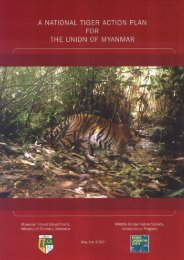Download - Global Tiger Initiative
Download - Global Tiger Initiative
Download - Global Tiger Initiative
You also want an ePaper? Increase the reach of your titles
YUMPU automatically turns print PDFs into web optimized ePapers that Google loves.
Credit: International Snow Leopard Trust<br />
Argali skull - Argali sheep constitute important Snow Leopard prey<br />
Marmota spp. also constitute important prey species, especially during the summer months<br />
(Schaller et al., 1988). Predation on domestic livestock can be significant and, in several<br />
regions, this has been directly attributed to a decreased availability of wild prey and increased<br />
human and livestock encroachment into Snow Leopard habitat (Nowell and Jackson, 1996).<br />
Distribution and population<br />
Snow Leopards are distributed in relatively low numbers in the high mountain ranges of central<br />
Asia and the Himalayan region. They are most numerous in the Tibet (Xizang) Autonomous<br />
Region and other parts of China, but their range includes territories in eleven other countries:<br />
Afghanistan, Bhutan, Kazakhstan, Kyrgyzstan, India, Mongolia, Nepal, Pakistan, the Russian<br />
Federation, Tajikistan and Uzbekistan (see Figure 1 and Table 1). The species is extinct in<br />
several areas of its former distribution. Snow Leopards have extremely patchy distribution and,<br />
although their range extends over a large area (more than 2.3 million km 2 ), their fragmented<br />
populations occupy an area of no more than 1.6 million km 2 (Jackson and Hunter, 1996).<br />
Worldwide population estimates for the species range between about 4000 and about 7000<br />
animals. Country estimates are shown in Table 1, but it is important to note that these estimates<br />
were based on data collected several years ago and that some populations could be at lower levels<br />
than those shown in the table. There have been numerous reports of population declines in most<br />
parts of the species’s range over the last decade. Snow Leopard numbers in Kyrgyzstan, for<br />
example, are reported to have decreased significantly since the early 1990s (Koshkarev and<br />
Vyrypaev, 2000). Any such declines would be of conservation concern: as long ago as 1975, the<br />
Snow Leopard was included in Appendix I of CITES, recognition that it was “threatened with<br />
extinction” (Anon., 1979). The species is also classified as Endangered in the 2002 IUCN Red<br />
List of Threatened Species (Anon., 2002b; Nowell, 2002) and has been so classified in IUCN Red<br />
Lists since 1988. According to the 2002 Red List, its predicted population trend is downward.<br />
FADING FOOTPRINTS: the killing and trade of Snow Leopards 5

















